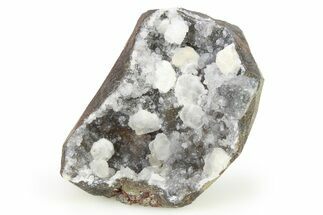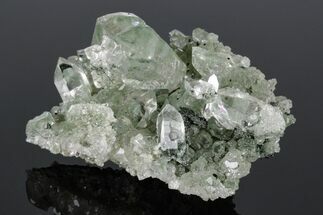This Specimen has been sold.
2.15" Amethyst, Calcite and Heulandite in Basalt - India
This is a beautiful, 2.15" tall specimen that features large amethyst crystals and a prominent clear heulandite crystal interspersed with translucent calcite sheets, collected from Madhya Pradesh, India. This formation occurred within a cavity, or vug, in the basalt host rock. Apophyllite, barite, and julgoldite crystals have also been found within some of these vugs.
Amethyst is a purple variety of quartz (SiO2) that owes its violet color to natural gamma irradiation, iron impurities, and the presence of trace elements, which result in complex crystal lattice substitutions. It is considered a semi-precious gemstone, and just two centuries ago was considered to have a value on par with diamonds, sapphires, and rubies. The largest and best known amethyst deposits occur in southern Brazil and Uruguay, where they are found in hydrothermally-formed geodes, but many localities around the world produce an amazing variety of amethyst crystals and formations. They are almost always formed in medium- to high-temperature geological settings.
Heulandite is a mineral of the zeolite group that also fits within the silicate and tectosilicates groups. It has the general chemical formula (Ca,Na)2-3Al3(Al,Si)2Si13O36 · 12H2O, but the calcium and sodium can be substituted by potassium, barium, or strontium ions. Heulandite crystals will often form as distinctive tabular, radiating crystals with a vitreous luster, and can display a variety of colors including white, green, brown, orange, red, pink, yellow, grey, and black.
About Calcite Crystals
Calcite crystals are a form of calcium carbonate (CaCO₃) known for their diverse shapes, transparency, and vibrant range of colors. They typically form in rhombohedral, scalenohedral, or prismatic shapes, often with well-defined, sharp edges and glossy surfaces. Calcite crystals are often translucent or transparent, sometimes displaying a double refraction effect where objects viewed through the crystal appear doubled. They can appear in various colors—white, clear, yellow, pink, blue, green, and orange—depending on impurities or trace minerals.
A notable characteristic of calcite is its reaction with weak acids like vinegar, which causes it to effervesce, or fizz, as it releases carbon dioxide. This property makes calcite crystals a key tool in geological identification and studies. Calcite forms in many environments, from sedimentary rocks like limestone and marble to hydrothermal veins.
Calcite crystals are a form of calcium carbonate (CaCO₃) known for their diverse shapes, transparency, and vibrant range of colors. They typically form in rhombohedral, scalenohedral, or prismatic shapes, often with well-defined, sharp edges and glossy surfaces. Calcite crystals are often translucent or transparent, sometimes displaying a double refraction effect where objects viewed through the crystal appear doubled. They can appear in various colors—white, clear, yellow, pink, blue, green, and orange—depending on impurities or trace minerals.
A notable characteristic of calcite is its reaction with weak acids like vinegar, which causes it to effervesce, or fizz, as it releases carbon dioxide. This property makes calcite crystals a key tool in geological identification and studies. Calcite forms in many environments, from sedimentary rocks like limestone and marble to hydrothermal veins.
SPECIES
Quartz var. Amethyst, Calcite & Heulandite
LOCATION
Khadakwani, Madhya Pradesh, India
SIZE
2.15 x 2.0"
CATEGORY
SUB CATEGORY
ITEM
#266952
 Reviews
Reviews












